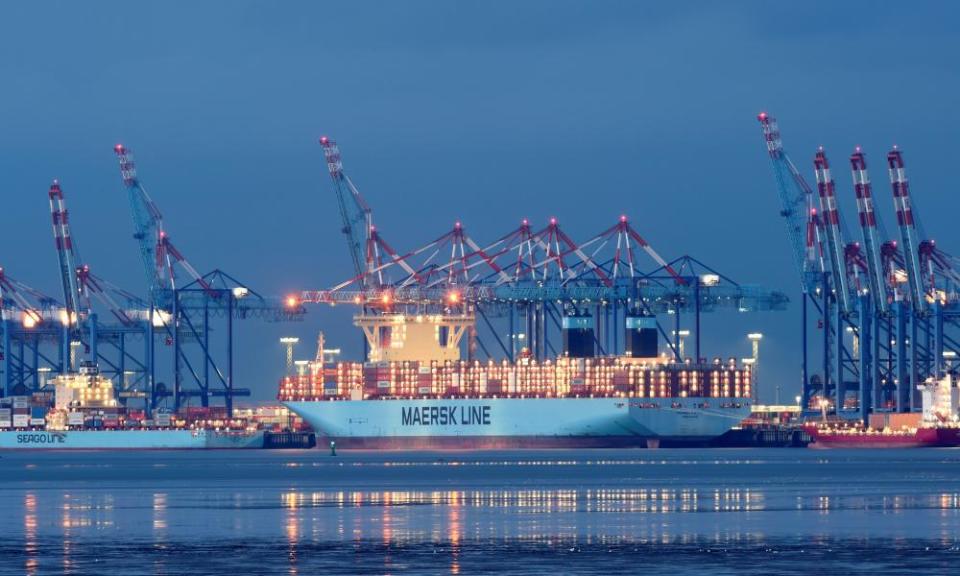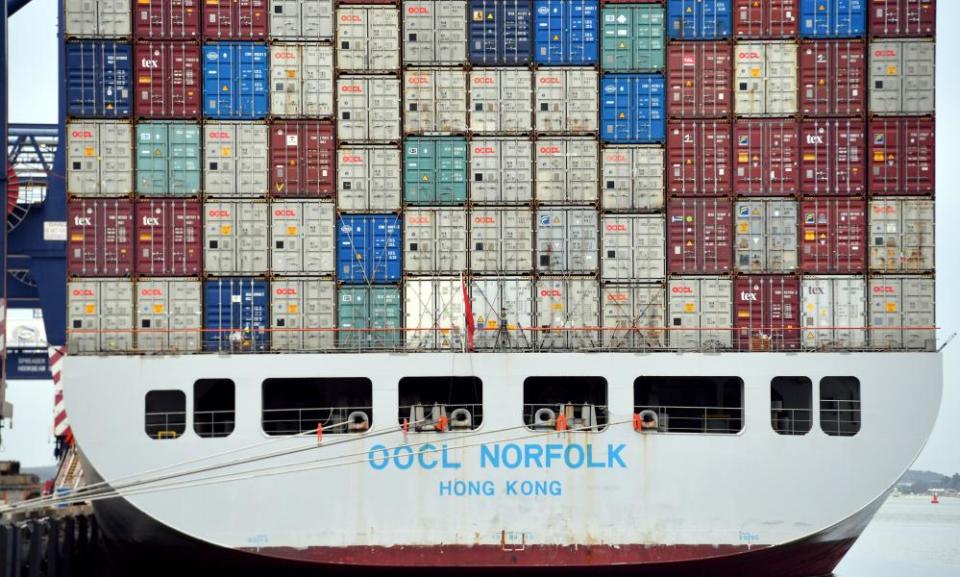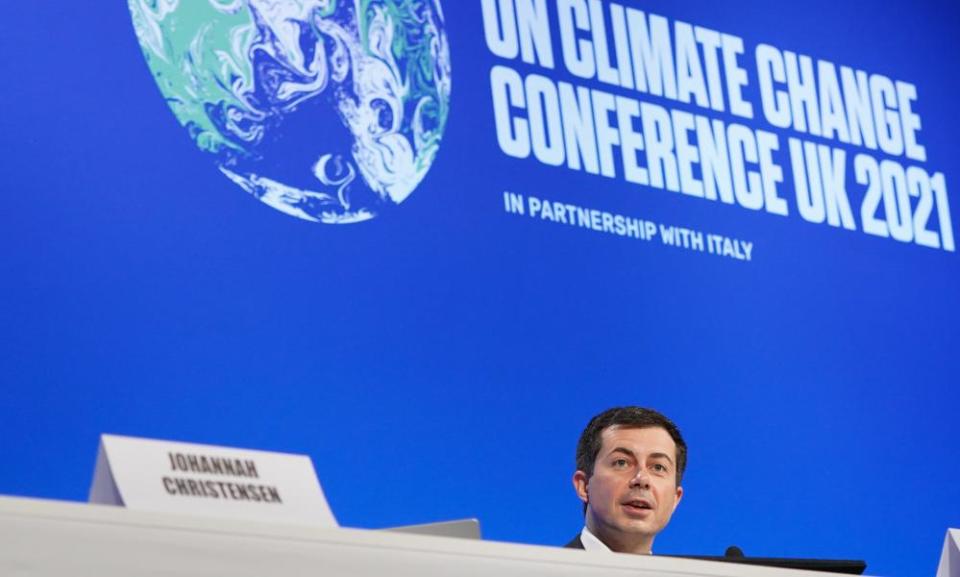The shipping industry faces a climate crisis reckoning – will it decarbonize?
In August, Maersk, the world’s largest shipping company, announced that it would add eight new container ships to its fleet that would be unlike any merchant vessels operating on the high seas today. Instead of running on “bunker” fuel – the gunky, tar-like substance left behind after oil is refined – Maersk plans to power these ships on carbon-neutral methanol, a colorless liquid made from biomass such as agricultural waste or by combining renewably generated hydrogen with carbon dioxide.
Globally, very little of this “green” methanol is produced today and compared with the oil industry waste product most ships run on, the cost is high. Maersk hasn’t yet announced a fuel supply for its new fleet but the company hopes that standing up the world’s first green methanol-powered fleet will spur the energy sector to significantly ramp up production of clean fuels.
“Rather than talking about how this can’t be done, let’s just get started and let’s start scaling,” said Morten Bo-Christiansen, the head of decarbonization at Maersk.
It’s a small step toward the enormous goal of decarbonizing shipping, an industry that accounts for roughly 3% of global greenhouse gas emissions and is far off track from meeting the goals of the Paris climate agreement.
Until now, shipping companies, which operate in remote international waters far from the public eye, have managed to avoid meaningful climate regulation. But the industry is facing a reckoning. The US, the EU and other big economies are starting to make pledges and draw up plans to green the shipping sector and at Cop26, a coalition of countries including the UK and the US signed a declaration committing to “strengthen global efforts” to reach net zero by 2050.
Business leaders are starting to take note. “Our crews see this as the number one thing on their boardroom agenda now,” said Guy Platten, the secretary general of the International Chamber of Shipping, a trade association that represents roughly 80% of the world’s merchant fleet.

A huge industry with a huge climate footprint
The shipping industry is a critical pillar of the global economy, with about 90% of all globally traded goods – from oil and steel to furniture and iPhones – ferried around the world by sea. In order to move all those goods, merchant ships burn approximately 300m metric tons of dirty fossil fuels each year, emitting roughly 1bn metric tons of carbon dioxide in the process. That is roughly equivalent to the annual carbon emissions of Japan.
The shipping industry will have to eliminate those carbon emissions by 2050 in order to stay in line with the Paris climate agreement’s 1.5C global heating target. But between 2012 and 2018, its emissions rose by 10%. The International Maritime Organization (IMO), the UN body that regulates shipping, predicts that by 2050, the industry’s emissions could be 30% higher than they were in 2008.
For that to change, tougher regulations are needed. The IMO adopted an initial energy efficiency regulation for ships in 2011, which set minimum fuel efficiency requirements per mile traveled and another one this June aimed at reducing the carbon intensity of ships by 40% by 2030.
Those standards have “basically codified a business as usual trend”, says Faïg Abbasov, the shipping program director at the Belgium-based non-profit Transport & Environment. The June measure requires shipping companies to give their vessels an A-E grade on energy efficiency and submit a “corrective action plan” for any ships that receive a D or E for three consecutive years. But the scores will not be made public and no mechanism exists to force dirty ships to improve, said Abbasov.
In 2018, the IMO set a goal of cutting the industry’s carbon pollution at least in half by 2050. But it hasn’t adopted any binding emissions reduction targets or regulations to achieve the target and even if it did, the goal is still far short of what’s needed to remain in line with the Paris agreement. Industry observers ascribe this partly to the slow nature of rule-making at the IMO, but also to corporate influence at the UN agency, where industry representatives are frequently appointed to serve on state delegations.
“There’s very little doubt” the shipping industry has stalled IMO climate regulations, said Aoife O’Leary, the CEO of Opportunity Green, a non-profit focused on international climate issues including shipping.
A patchwork of regulations
But change appears to be on the horizon. The EU is now moving to regulate shipping emissions under its emissions trading system, with a phase-in beginning in 2023. Under the proposed law, by 2026 shipping companies will need to pay for the carbon they emit traveling to and from the EU and between EU ports.
Separately, the EU is proposing a fuel mandate that would compel the industry to use a progressively greater share of low- and zero-carbon fuels in its ships. And in April, the US committed to pursuing a zero emissions shipping industry by 2050.
While the shipping industry has pushed back against the idea of a patchwork of climate regulations across different nations, O’Leary said these could compel the IMO to take more ambitious action. “If you look at the history of IMO regulations, they’ve often acted because the EU or the US have acted on their own,” she said.
The industry does seem more eager to talk about climate. In March, the International Chamber of Shipping proposed a carbon levy of $2 a metric ton of fuel to go towards research and development of clean shipping technology. This proposal, along with a far more ambitious proposal by the Marshall Islands to tax merchant vessels to the tune of $100 a metric ton of bunker fuel, will be discussed at an IMO meeting in late November.
Platten of the International Chamber of Shipping wouldn’t say whether the industry would support the specific fuel tax proposed by the Marshall Islands. But he said that shipping businesses “welcome the discussion and debate of market-based measures” to drive down emissions and make low and zero carbon synthetic fuels more economically viable. In October, the ICS called for next zero emissions for the industry by 2050, doubling the ambitions of the IMO.

The quest for zero carbon fuel
Transforming the shipping sector means zero-carbon fuels must become available on a commercial scale, along with the infrastructure required to pump them into ships. Green methanol, ammonia and hydrogen can all be made with renewable energy, in processes that start with splitting water in an electrolyzer to produce hydrogen. But while green methanol can be dropped into existing ships with fairly minimal retrofits, the other two will require significant modifications of ship designs and operational procedures.
Ammonia and hydrogen are gases at room temperature and will need refrigerated tanks to store as liquids. Ammonia is also toxic to marine life and humans, raising safety and environmental concerns. Hydrogen, meanwhile, has a very low energy density compared with oil, which means that ships using it would have to carry much larger volumes of fuel, or be refilled far more often.
Proving that alternative fuels are safe and reliable to use on commercial vessels, then scaling them up and deploying them across the global shipping industry will be an expensive and time-consuming endeavor.
“What we are really looking at is decades of investment and innovation ahead of us,” said Bo Cerup-Simonsen, the CEO of the Maersk Mc-Kinney Moller Center for Zero Carbon Shipping, a research and development center. “It’s fair to say that we’re talking billions,” he said, “but I think the trillions come when we start to scale this up to become industry wide.”
Researchers have estimated that if zero emissions fuels comprise 5% of the international shipping fuel mix by 2030, the industry will be on a path to fully decarbonize by 2050. The Global Maritime Forum’s Getting to Net Zero Coalition believes that target is achievable based on recently announced plans, including the EU’s 2020 Hydrogen Strategy, which calls for building at least 40 gigawatts of renewable hydrogen electrolyzers by 2030, as well as China and Japan’s goals to ramp up hydrogen fuel production.

‘We’re not there just yet’
While the task ahead is daunting, Cerup-Simonsen is optimistic. The number of large companies expressing interest in carbon-free shipping is growing “day by day”, he said, as is interest from their customers. “You’re seeing mining companies, some of the big retailers, big auto manufacturers starting to demand a greening of their supply chains, including shipping,” Cerup-Simonsen said.
Large consumer-facing businesses could be key in helping to drive change in the shipping industry, says Madeline Rose, the climate campaign director at Pacific Environment who recently led a report on the shipping pollution associated with 15 major retail brands, including Amazon, Walmart and Target.
In 2019 alone, the report found that these companies were responsible for three coal fired power plants’ worth of carbon pollution through their US shipping imports. Despite making ambitious climate pledges in recent years, most of the companies highlighted in the report do not appear to account for marine pollution in their corporate emissions reporting.
Amazon, along with companies including Ikea and Unilever, signed a pledge in October to only move goods on ships using zero carbon fuel by 2040.
While retailers demanding cleaner shipping could motivate shipping companies to bring new options online faster, Abbasov of Transport & Environment is doubtful that voluntary corporate pledges will drive transformative change. For now, he says, regulations are needed to make alternative fuels more economically attractive and prevent corporate greenwashing.
“Once there are regulations, once the technology has become very common, individual companies can take one extra step and go further than the law says,” Abbasov said. “For shipping, we’re not there just yet.”

 money
money 